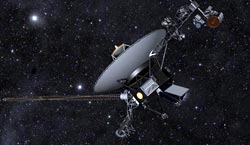Voyager 1 spacecraft reaches interstellar space

An artist's concept shows the Voyager spacecraft traveling through space against a field of stars. Image courtesy of NASA/JPL-Caltech.<br>
University of Iowa space physicist Don Gurnett says there is solid evidence that NASA’s Voyager 1 spacecraft has become the first manmade object to reach interstellar space, more than 11 billion miles distant and 36 years after it was launched.
The finding is reported in a paper published in the Sept. 12 online issue of the journal Science.
“On April 9, the Voyager 1 Plasma Wave instrument, built at the UI in the mid-1970s, began detecting locally generated waves, called electron plasma oscillations, at a frequency that corresponds to an electron density about 40 times greater than the density inside the heliosphere—the region of the sun’s influence,” says Gurnett. “The increased electron density is very close to the value scientists expected to find in the interstellar medium.
“This is the first solid evidence that Voyager 1 has crossed the heliopause, the boundary between the heliosphere, and interstellar space,” says Gurnett, principal investigator for the plasma wave instrument.
For several months, the relative position of Voyager 1 has stirred something of a scientific debate because there remains some lingering evidence of the nearby heliosphere beyond the heliopause.
Even though Voyager 1 has passed into interstellar space, it does not mean that its journey is over, says Bill Kurth, UI research scientist and co-author of the Science paper.
“Now that we’re on the outside, we are learning that interstellar space isn’t a bland region,” Kurth says. “Rather, there are variations in some of Voyager’s measurements that may be due to the nearby presence of the heliosphere. So, our attention is turning from crossing the boundary to understanding what is going on outside,” he says.
At age 36, Voyager 1 is the most distant human-made object at more than 11.6 billion miles from the sun, or about 125 astronomical units.
“At that distance it takes more than 17 hours for a radio signal to travel from the spacecraft to one of NASA’s Deep Space Network antennas. The signal strength is so incredibly weak that it takes both a 230-foot and a 110-foot-diameter antenna to receive our highest resolution data,” Gurnett says.
Launched Sept. 5, 1977, Voyager 1 completed flybys of both Jupiter and Saturn and is currently moving outward from the sun at about 3.5 AU per year. A sister spacecraft, Voyager 2 was launched Aug. 20, 1977, on a flight path that took it to encounters with Jupiter, Saturn, Uranus, and Neptune. At present, Voyager 2 is still inside the heliosphere about 103 AU from the sun and traveling outward at about 3.3 AU per year.
The sounds of the electron plasma oscillations heralding Voyager’s entry into interstellar space and other sounds of space can be heard by visiting Gurnett’s website.
Gunett’s and Kurth’s co-authors on the Science paper are L.F. Burlaga of NASA/Goddard Space Flight Center, Greenbelt, Md.; and N.F. Ness of The Catholic University of America, Washington, D.C.
NASA’s Jet Propulsion Laboratory (JPL), Pasadena, Calif., a division of Caltech, manages the Voyager mission for NASA's Science Mission Directorate, Washington, D.C. For more information on Voyager, visit the NASA website.
Contacts
Don Gurnett, Department of Physics and Astronomy, 319-400-3156
Bill Kurth, Department of Physics and Astronomy, 319-335-1926
Gary Galluzzo, University Communication and Marketing, 319-384-0009
Media Contact
More Information:
http://www.uiowa.eduAll latest news from the category: Physics and Astronomy
This area deals with the fundamental laws and building blocks of nature and how they interact, the properties and the behavior of matter, and research into space and time and their structures.
innovations-report provides in-depth reports and articles on subjects such as astrophysics, laser technologies, nuclear, quantum, particle and solid-state physics, nanotechnologies, planetary research and findings (Mars, Venus) and developments related to the Hubble Telescope.
Newest articles

Superradiant atoms could push the boundaries of how precisely time can be measured
Superradiant atoms can help us measure time more precisely than ever. In a new study, researchers from the University of Copenhagen present a new method for measuring the time interval,…

Ion thermoelectric conversion devices for near room temperature
The electrode sheet of the thermoelectric device consists of ionic hydrogel, which is sandwiched between the electrodes to form, and the Prussian blue on the electrode undergoes a redox reaction…

Zap Energy achieves 37-million-degree temperatures in a compact device
New publication reports record electron temperatures for a small-scale, sheared-flow-stabilized Z-pinch fusion device. In the nine decades since humans first produced fusion reactions, only a few fusion technologies have demonstrated…





















